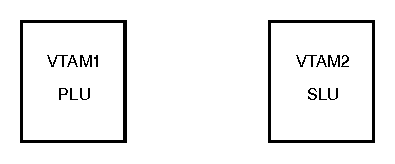 z/OS Communications Server: SNA Network Implementation Guide
z/OS Communications Server: SNA Network Implementation Guide
 z/OS Communications Server: SNA Network Implementation Guide
z/OS Communications Server: SNA Network Implementation Guide
|
Previous topic |
Next topic |
Contents |
Contact z/OS |
Library |
PDF
APPN and subarea Class of Service resolution z/OS Communications Server: SNA Network Implementation Guide SC27-3672-01 |
|
|
In a subarea network, the LOGMODE resolves to a subarea COS at
the SLU SSCP. In Figure 1, the following
cases occur in a subarea environment:
Figure 1. LOGMODE resolution example
 In an APPN network, the LOGMODE is always resolved to an APPN COS
at the CP(OLU) or NNS(OLU). Using Figure 1, the following cases occur in an APPN environment:
This difference between the architectures (subarea and APPN) creates
new considerations in the implementation of mixed APPN and subarea
networks, especially when you consider the fact that VTAM® allows for different LOGMODE tables to
be defined for various LUs. For example, consider a PLU-initiated
session in both a subarea and an APPN network configuration.
If every possible SLU is predefined as a CDRSC in every VTAM that has a PLU that might wish to start a session with these SLUs, the MODETAB operand can be added to these CDRSCs to make sure the correct LOGMODE table (and, therefore, APPNCOS) is selected. However, requiring SLU definitions at every possible PLU VTAM is both undesirable and unreasonable in an APPN environment. Using dynamic CDRSCs for these SLUs is easier to maintain. Without any definition changes, the default logon mode table (ISTINCLM) is used for dynamic CDRSCs. In addition, to ensure required logmode to COS resolution, all SLUs need to be defined at any VTAM that is an intermediate network node on the BIND path. For example, if a composite network node existed between VTAM1 and VTAM2, the CNN would have to be able to resolve the LOGMODE name to a subarea COS so that an appropriate ER and VR can be chosen through the CNN. Because neither the PLU nor SLU has been predefined to the CNN, dynamic CDRSCs are created for both and the SLU would inherit ISTINCLM as it logon mode table. To ensure that the required COS is being used when LU-LU session requests use both APPN links and subarea VRs, there are several choices available for specifying the appropriate APPN and subarea COS for a given logon mode name. The following choices are provided in order of the preference used by VTAM for COS selection.



|
 Copyright IBM Corporation 1990, 2014 Copyright IBM Corporation 1990, 2014 |